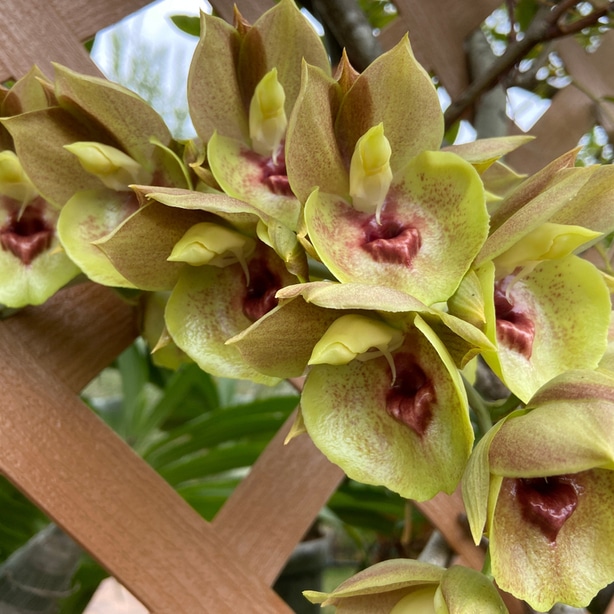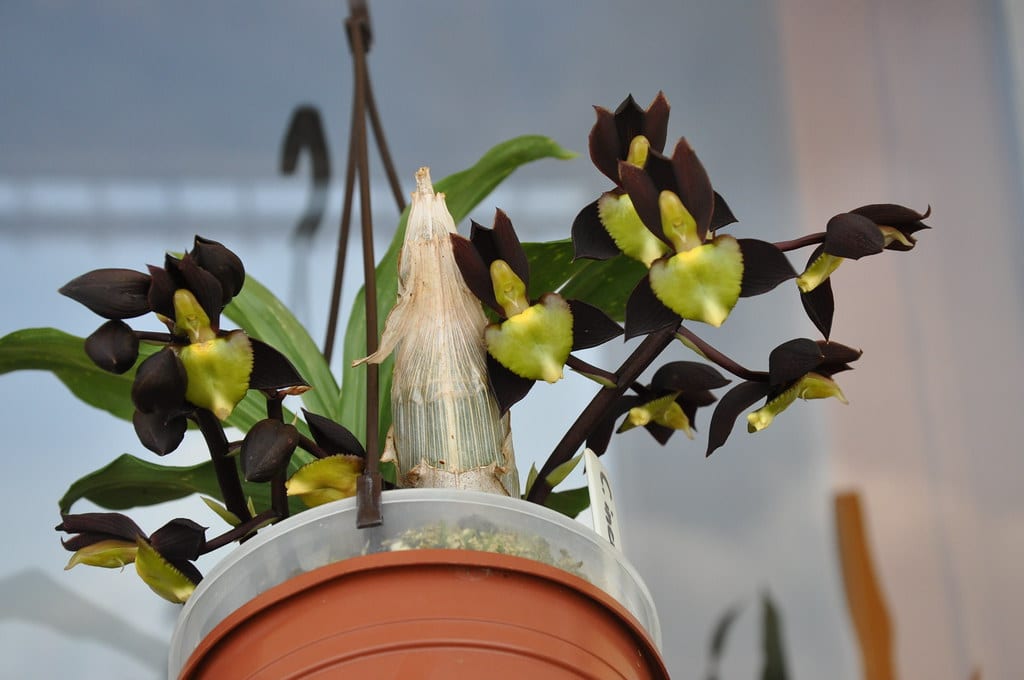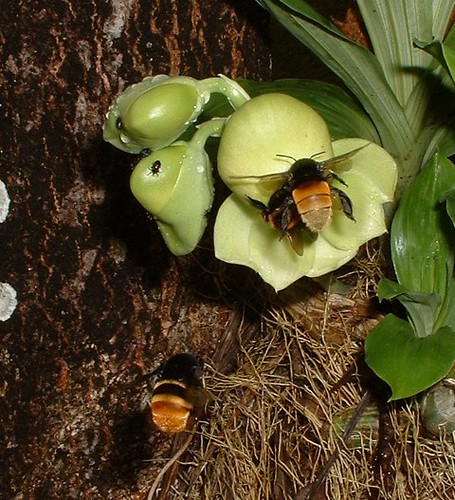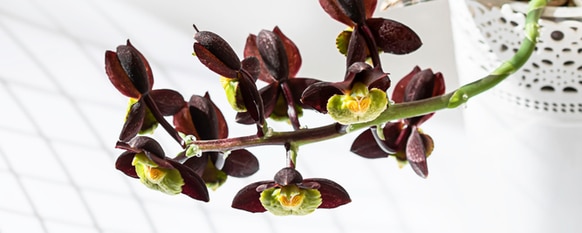The Catasetum orchid is an ideal choice when leisure time is a luxury and exotic beauty is a must.
Members of this species are recognized as being some of the least labor-intensive to raise. Success hinges only on replicating its preferred growing conditions. As such, this colossal beauty is well suited for beginners. It grows fast. It is difficult to over-water, as it must be well hydrated, and can store water.
This fragrance-rewarding species pleases olfactory senses with a range of notes. Some describe its aroma as a combination of spice, mint, and pepper notes. However, some members of this species exude citrus notes. The fragrance of others is characterized more like rye bread.
If you like these tropical flowering plants, then you will also like plumerias. Learn how to grow plumeria trees that will produce colorful blooms.

General Information
Pronounced kat-ah-SEE-tum, the name is derived from the Greek word kata, which means downward, and the Latin word seta, meaning bristle. The species was discovered by Louis Claude Richard in the 1820s.
Native to Central and South America, it is primarily a tree-dweller. Look for it growing in tropical tree canopies or the boot of palm trees. The boot is created at the base of the tree when leaves are shed. In short, this heat-loving charmer likes moist environments and thrives in bright conditions.
Its growing cycle is highly regimented, although it will blossom unpredictably. Resting periods are part of the annual cycle and may give the appearance that the plant has died. Like bears hibernating, the plant is simply recharging during this dormancy. It is preparing for a vivid rebirth. The dormant stage can vary in length, from a few weeks to a few months.
The Catasetum flower’s relatively short life expectancy can be traced to its DNA. Their brilliance may only shine for a few days.
But heredity is not the only determining factor. Blossoms are intimately dependent on temperature and humidity. High-summer heat will sap the life from the cascading blooms in less than a week. Those plants that postpone blooming until cooler weather – late fall or early winter – may enjoy two full weeks of glory.
Low humidity is known to wreak havoc on these lovelies. The deadliest duo, though, is high temperature combined with low humidity.

Make sure to also check our how to properly care for cypripedium orchids in our article here on the Green Pinky.
Care
Temperature
For best results, while your plant is growing, maintain daytime temperatures between 80° to 100° F. Drop the temperature to 60° or 65° F during the night. Once your plant reaches maturity, the heat can be reduced even further. Mature plants can be maintained at 70° to 85° F during the day and 55° F once night falls.
Light
The Catasetum demands bright, plentiful light throughout the growth cycle, but especially as the end of the cycle nears.
When the Catasetum first awakens from its resting period, it can be satisfied with a bit less intensity. It will grow well early in the cycle with between 1,500 and 3,000 foot-candles.
During most of the growth cycle, though, the Catasetum does best with light levels that range from 3,000 to 6,000 foot-candles. This translates to one-half to three-fourths full sun.
Light is also necessary during the dormant, recharging period in the fall. Make sure your light is buffered, though. Direct, harsh light is not helpful. It can result in yellow/brown leaves that look scorched.

Water and Humidity
Most of the time, it’s safe to assume this plant is thirsty. Water is its lifeblood. The plant uses water continuously for rapid and splendid growth. It also stores water for sustenance during the dormant stage.
Large quantities of water – typically given twice per week – will be necessary to form the pseudobulb and spark leaf growth properly. Once the plants have flowered, taper the amount of water offered.
Experts share that the required water is relative to the leaf surface and root system. As these parameters increase, so, too, should the water. When you water, be sure to saturate the medium, persisting until you see water seeping from the bottom.
Caregivers should eliminate watering altogether once the pseudobulb matures and the leaves start to yellow and drop. These occurrences signal the onset of the dormant stage. If you notice the pseudobulbs have shriveled severely, offer a bit of water.
Watering should resume at the first signs of new growth. This helps the plant to produce a strong root system.
Humidity should be at 40 to 60 percent, although some growers recommend as high as 70 percent. As with other orchids, placing the pot on a bed of stones that are sitting in water will optimize humidity. Make sure the air is moving to prevent disease growth and watch the leaves.
This orchid produces an excessive amount of sap that can make the leaves sticky and attract layers of dust. Be mindful that dry, stagnant air will attract spider mites. Caregivers should work hard to maintain optimal moisture, high humidity, and strong air movement while the plants are growing.
Feeding
To maximize your Catasetum’s potential and make it as strong as possible, fertilize once every two to three weeks. This will produce strong pseudobulbs and boost the blossoms. The ideal method is to use a diluted mixture. Mix the fertilizer with the water. If this is not possible, feeding less infrequently with concentrated applications can work. It is just not optimal.
These orchids enjoy a high nitrogen formulation (such as 30-10-10) during the growth phase. Gradually reduce the amount and frequency as pseudobulbs form. Once the leaves have dropped, adjust your fertilizer’s formula to a 10-30-20 mix.
To enhance blossoms, switch your fertilizer’s formula to 10-30-20. Apply in the autumn or spring, depending on when your plant blooms.

Potting and Medium
Repot these orchids every year. The intense watering accelerates the breakdown of the potting medium. Repotting should be timed to sync with the onset of new growth. This timing minimizes risk. New roots can develop quickly at this stage.
These plants have robust root systems that do well in a variety of media, depending on the pot. Sphagnum is ideal for clay pots. Medium-fine fir bark can also be used in clay pots as well as plastic pots and baskets. A wide variety of other substrate media may be considered as well. For example, combinations of osmunda, tree fern fiber, charcoal, sponge rock, perlite, leaf mold, peat, and bark screenings can be used as long as it is in the correct ratios.
Take care to give the root system plenty of room to breathe. It is easy to suffocate the root system. This will lead to root rot. Unless you live in a region that closely resembles the colossal specimen’s native lands, it is recommended that you keep your containers inside where you can better control the temperature and humidity. That said, you may want to bring the pots outside during the summer, assuming you can monitor and maintain your plant’s water and humidity needs.
Propagation
This waxy-leafed prize is unisex. This is a rare phenomenon in the world of orchids. They have earned this distinction because each flower has both male and female anatomy. The staminate is male and the pistillate is female. In most cases, only organs of one sex are functional in the flower. However, in some cases, this orchid has been known to produce hermaphroditic (bisexual) flowers.
Male plants present with bodacious, colorful flowers. Conversely, female plants are found in the yellow-green range of the color wheel. Female flowers are smaller than their male counterparts. Both species are treasured for their versatility and beauty.
In addition to color, the gender of this vigorous grower’s fleshy flower can be determined by its shape. More than a dozen basic shapes have been noted for male flowers. Orchids with female-dominant flowers, on the other hand, typically have the same shape. The amount of light and water are responsible for determining the type of flowers produced.
Flower clusters emerge from nodes. Nodes are found at the base of the pseudobulb, which is usually tapered at both ends. These clusters most commonly form a graceful arch. The Catasetum’s leaves are full of surprises. They appear in a variety of sizes. Sometimes the leaves will be short and narrow. Other times, they provide a large-scale backdrop for the beautiful flowers, growing as long as 60 cm and up to 10 cm wide. Leaves are also full of surprises. Some will be light green, signaling possible sun overexposure. In other situations, the orchid’s leaves will select a medium to dark green shade.
This orchid is distinctive also for its approach to pollination. It releases pollen using tiny hairs. The deciduous plant proactively attaches its pollen sacs onto pollinators. Pollinators can be insects like bees, butterflies, moths, or other species like bats and hummingbirds.

Varieties
The World Checklist of Monocotyledons recognizes 64 species and 9 natural hybrids.

